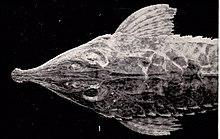| Hemiodontichthys | |
|---|---|

| |
| Scientific classification | |
| Domain: | Eukaryota |
| Kingdom: | Animalia |
| Phylum: | Chordata |
| Class: | Actinopterygii |
| Order: | Siluriformes |
| Family: | Loricariidae |
| Subfamily: | Loricariinae |
| Tribe: | Loricariini |
| Genus: | Hemiodontichthys Bleeker, 1862 |
| Species: | H. acipenserinus |
| Binomial name | |
| Hemiodontichthys acipenserinus (Kner, 1853) | |
Hemiodontichthys is a monotypic genus in the family Loricariidae, under the order Siluriformes (catfishes and their kin), containing a single species, Hemiodontichthys acipenserinus, also known as the Pinocchio whiptail catfish, Pinocchio catfish, Pinocchio cat or the knob-nosed whiptail. This shy, bottom-dwelling catfish is native to the Guianas, Brazil, Bolivia and Perú in South America.
Taxonomy
As a taxon, Hemiodontichthys is often compared with the morphologically-similar Reganella depressa, to the point that the two have been considered sister genera (on the basis of osteological data), although the similar external morphology of the two taxa may be viewed as evolutionary convergence, as the species occupy a similar ecological niche. In both, there is a rostrum and the loss of maxillary teeth, traits which could have evolved independently in different lineages subjected to similar environmental pressures. However, having considered some of the key morphological differences between the two genera, Hemiodontichthys is now believed to be part of the Loricariichthys group, while Reganella is part of the Pseudohemiodon group.
Distribution
H. acipenserinus is native to the countries of Bolivia, Brazil, French Guiana, Guyana and Perú, where it occurs in the Amazon, Essequibo, Oyapock, and Paraguay River basins.
Description
Hemiodontichthys acipenserinus reaches a length of 13.4 centimetres (5.3 in) SL. It has been reported that populations from the Amazonian region tend to be more slender than those from the Paraguay and Guaporé Rivers.
Ecology
H. acipenserinus is a reclusive bottom-dweller that spends much of its time partially buried in the substrate (similar to rays or flatfishes), with its cryptic and sandy coloration providing efficient camouflage. It lives on and in the fine-sand bottoms of rivers, where it feeds on various small, aquatic invertebrates and their larvae, including worms, brine shrimp, micro-crustaceans and other freshwater microfauna.
As with other species of the Loricariichthys group, mature male Pinocchio catfish develop hypertrophied lips for brooding eggs. They develop a huge labial veil, and grow teeth with spoon-shaped crowns; in females and juveniles, the crowns are pointed. Unlike most loricariids, Pinocchio cats do not develop prominent odontodes on the snout and pectoral fins. Eggs are laid en masse, protected by the male within the folds of his enlarged lips, ventilating his brood during times of movement. Around one week after hatching, the alevins abandon their parental protection.
References
- ^ "Hemiodontichthys acipenserinus (Pinocchio Whiptail Catfish) - Seriously Fish". SeriouslyFish.com. Retrieved 3 March 2024.
- Ferraris, Carl J. Jr. (2007). "Checklist of catfishes, recent and fossil (Osteichthyes: Siluriformes), and catalogue of siluriform primary types" (PDF). Zootaxa. 1418: 1–628. doi:10.11646/zootaxa.1418.1.1.
- ^ Covain, Raphael; Fisch-Muller, Sonia (2007). "The genera of the Neotropical armored catfish subfamily Loricariinae (Siluriformes: Loricariidae): a practical key and synopsis" (PDF). Zootaxa. 1462: 1–40. doi:10.11646/zootaxa.1462.1.1.
- ^ Froese, Rainer; Pauly, Daniel (eds.). "Hemiodontichthys acipenserinus". FishBase. December 2011 version.
| Taxon identifiers | |
|---|---|
| Hemiodontichthys | |
| Hemiodontichthys acipenserinus | |